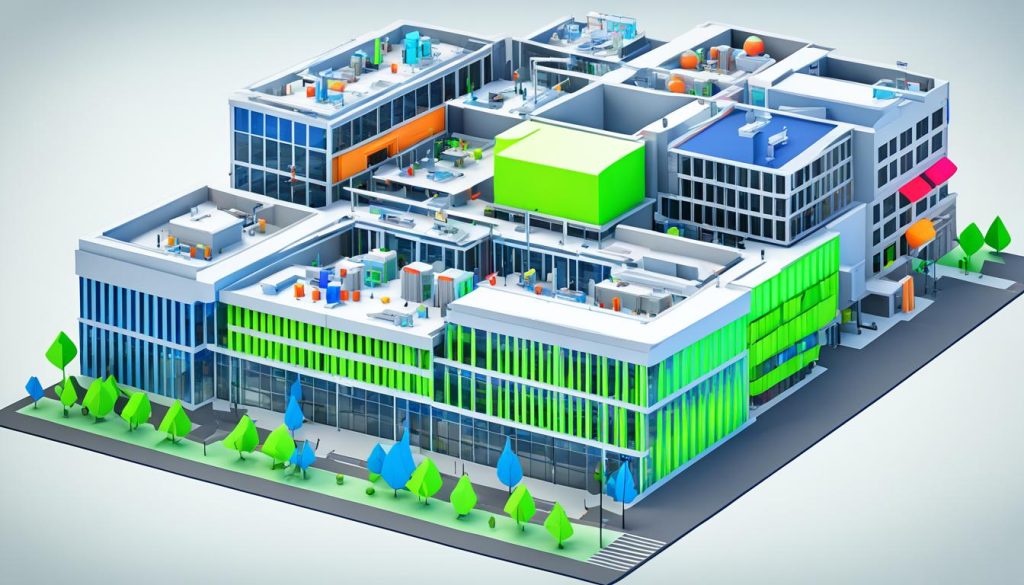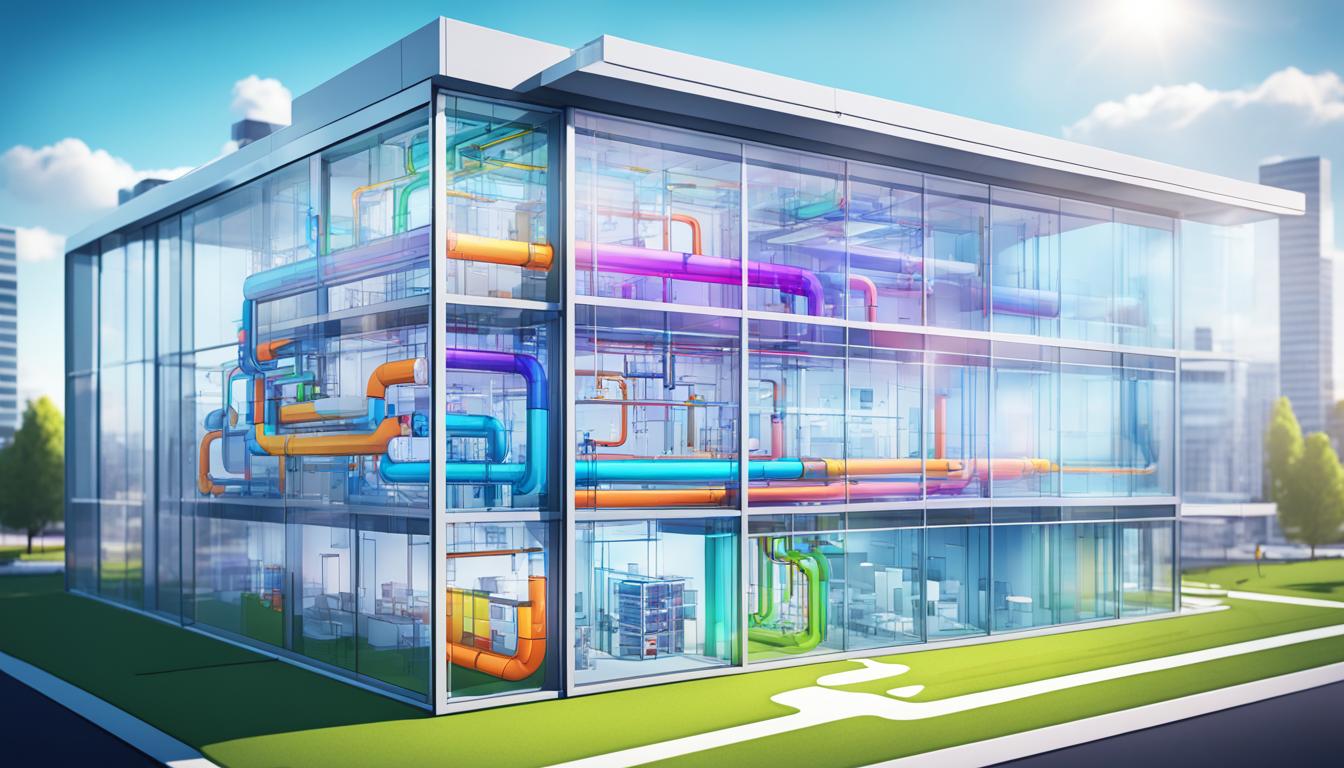You can link commercial HVAC load estimation with Building Information Modeling (BIM) using advanced software and a clear plan. This combo boosts project coordination, cuts down on mistakes, and makes your building more energy-efficient.
BIM has changed the game for HVAC design. It lets you model, analyze, and document your designs all in one place. Adding load calculation to your BIM workflow makes the design smoother and boosts system performance.
With tools like Autodesk Revit, you can do energy analysis and load estimations right in your BIM model. This way, you can make smart choices, size systems right, and lower costs for your commercial HVAC projects.
We’ll dive into the main parts of this integration, the best ways to put it into action, and how it can really help your project coordination.
Understanding the Synergy Between BIM and HVAC Load Estimation
BIM and HVAC load estimation are changing commercial building design. Together, they make the building process more efficient, accurate, and collaborative.
Defining Building Information Modeling (BIM)
BIM is a digital model of a building’s design and details. It’s more than just 3D models. It includes info on materials, systems, and sizes. You can use software like Trimble SketchUp, Dassault Systèmes SolidWorks, Bentley MicroStation, and Nemetschek Vectorworks for BIM.
The Importance of HVAC Load Estimation in Commercial Buildings
Estimating HVAC loads is key for keeping buildings comfortable and energy-efficient. It calculates heating and cooling needs based on building size, direction, use, and climate. Getting it right means avoiding energy waste and ensuring systems work well.
Benefits of Integrating HVAC Load Estimation with BIM
Using BIM and HVAC load estimation has many benefits:
- Improved accuracy in calculations
- Enhanced collaboration among project teams
- Streamlined design process
- Better visualization of HVAC systems within the building structure
- Easier detection of potential conflicts or inefficiencies
By using BIM for HVAC load modeling, designers can make buildings more efficient and cost-effective. This approach allows for quick changes and improvements during design. It leads to better building performance and comfort for everyone inside.
Key Components of Commercial HVAC Load Estimation
Estimating the HVAC load for commercial buildings is key to designing efficient heating and cooling systems. Knowing the main parts of this process helps you make a better Load Calculation Methodology. Let’s look at the main elements that make commercial HVAC load estimation precise.
Thermal Zone Identification
First, you need to identify thermal zones in the building. This means dividing it into areas that need the same temperature and usage patterns. Doing this makes sure each space gets the right heating or cooling, which improves Indoor Air Quality (IAQ).
Building Envelope Analysis
Looking at the building’s envelope is crucial for precise load calculations. This means checking insulation, windows, doors, and the roof. A detailed check helps figure out how much heat the building loses or gains, which affects the HVAC system’s efficiency.
Internal Heat Gain Calculations
Internal heat sources greatly impact the HVAC load. You must consider the heat from people, lights, and machines. These sources add to the total thermal load and affect how big the cooling system needs to be.
Climate Data Consideration
The local climate is very important for HVAC load estimation. You need to look at temperature extremes, humidity, and sunlight levels in your area. This info helps figure out the highest heating and cooling needs throughout the year.
| Component | Impact on Load Calculation | Relevance to Energy Analysis |
|---|---|---|
| Thermal Zones | Defines specific HVAC requirements | Optimizes energy distribution |
| Building Envelope | Determines heat transfer rates | Influences insulation needs |
| Internal Heat Gains | Affects cooling load calculations | Impacts equipment sizing |
| Climate Data | Establishes peak load conditions | Guides system design parameters |
By thinking about these key parts in your Load Calculation Methodology, you’ll get a more precise and efficient HVAC system design. This method leads to better Energy Analysis results and improved Indoor Air Quality (IAQ) in commercial buildings.
BIM Software Tools for HVAC Design and Analysis
When working on HVAC design and analysis, you have many BIM software tools to choose from. These tools help make your work easier and more accurate. They make load calculations smoother.
Autodesk Revit is a top pick for HVAC pros. It has built-in tools for load calculations and lets you integrate HVAC systems into building models easily. You can make detailed 3D models of ductwork, piping, and equipment.
Trimble SketchUp is known for 3D modeling but also has HVAC design extensions. Its easy-to-use interface is perfect for quick designs and presentations. You can do basic load calculations and see airflow patterns with plugins.
Dassault Systèmes SolidWorks is great for detailed HVAC analysis. It lets you do thermal analysis, fluid dynamics studies, and improve system performance. This tool is very comprehensive.
Bentley MicroStation is ideal for big HVAC projects. It has strong modeling tools for detailed HVAC layouts and energy analysis in one place.
While these BIM tools have different HVAC features, you might need extra software for precise load modeling. The goal is to pick the right tools that fit your project and work style.
Steps to Integrate Commercial HVAC Load Estimation with BIM
Integrating commercial HVAC load estimation with Building Information Modeling (BIM) needs a step-by-step plan. This process makes HVAC system design and energy analysis better. It leads to more efficient and cost-effective buildings. Let’s look at the main steps for this integration.
Creating a Comprehensive BIM Model
The first step is to make a detailed 3D BIM model. This model should have architectural elements, structural parts, and layouts. It’s important to get the building’s shape, materials, and how it faces the sun right for accurate HVAC load calculations.
Extracting Relevant Data for Load Calculations
After the BIM model is ready, pull out the data needed for HVAC load estimation. This includes how the building is oriented, its insulation, window sizes, and how often it’s used. BIM software can do this automatically, saving time and cutting down on mistakes.
Utilizing BIM-Integrated HVAC Analysis Tools
Next, use BIM-integrated HVAC analysis tools. These tools run simulations and do energy analysis with the data you pulled out. They figure out heating and cooling needs, check how well the system works, and give tips for better HVAC design.
| BIM-Integrated Tool | Primary Function | Key Benefit |
|---|---|---|
| Autodesk Revit MEP | HVAC system modeling | Seamless integration with architectural models |
| IES Virtual Environment | Energy simulation | Comprehensive performance analysis |
| EnergyPlus | Load calculation | High accuracy in energy consumption prediction |
Iterative Design Process and Optimization
The last step is an iterative design process. Use the analysis results to improve the system design. Change things in the BIM model, run simulations again, and keep tweaking until you hit the right energy use and comfort levels. This back-and-forth approach makes sure your commercial building’s HVAC system is as efficient as possible.
Overcoming Challenges in BIM-HVAC Integration
Integrating Building Information Modeling (BIM) with HVAC systems has many benefits. But, it comes with its own set of challenges. Let’s look at the main hurdles and how to get past them.
Data Interoperability Issues
One big challenge is getting different software to talk to each other. This can cause mistakes in how we calculate loads and analyze energy use. Here’s how to fix it:
- Use Industry Foundation Classes (IFC) format for data exchange
- Implement middleware solutions to bridge software gaps
- Regularly update your software to ensure compatibility
Ensuring Accuracy of Input Parameters
Getting the input data right is key for a good HVAC design. Wrong data can make systems too big or too small, hurting energy use and comfort. Here’s how to get it right:
- Conduct thorough site surveys
- Use advanced measurement tools for precise data collection
- Implement rigorous quality control checks
Managing Complex Building Geometries
Today’s buildings can be very complex, making them hard to model. This can mess with how we divide the space for heating and cooling. Here’s what to do:
- Break down complex geometries into simpler forms
- Use advanced 3D modeling techniques
- Collaborate closely with architects to understand design intent
| Challenge | Impact | Solution |
|---|---|---|
| Data Interoperability | Errors in load calculations | Use IFC format, middleware |
| Input Parameter Accuracy | Inefficient system sizing | Thorough surveys, quality checks |
| Complex Geometries | Inaccurate thermal zoning | Advanced 3D modeling, collaboration |
By tackling these issues, we can make BIM and HVAC systems work better together. This leads to designs that are more efficient and accurate. Remember, always keep learning and adapting in this fast-changing field.
Enhancing Coordination Through BIM-Integrated HVAC Design
Building Information Modeling (BIM) changes HVAC system design by bringing everyone together on one platform. This makes working together easier for architects, engineers, and contractors. It leads to better results for the project.

- Clash detection between HVAC components and other building systems
- Streamlined energy analysis and optimization
- Accurate documentation for construction planning and maintenance
- Reduced errors and improved overall building design process
Using BIM in HVAC design lets you see the whole building. This helps in making better decisions and solving problems more efficiently. It makes the project smoother from start to finish.
With BIM, energy analysis gets a big boost. You can test different scenarios to make HVAC systems work better. This leads to solutions that are good for the planet and save money. It also helps meet energy goals and rules.
| Traditional HVAC Design | BIM-Integrated HVAC Design |
|---|---|
| Limited collaboration | Seamless team coordination |
| 2D drawings | 3D models with rich data |
| Manual clash detection | Automated conflict resolution |
| Basic energy analysis | Advanced simulation capabilities |
BIM makes working on HVAC projects much better. It keeps everyone updated in real time. This means less mistakes, less redo work, and projects finish faster.
Best Practices for Efficient HVAC Load Estimation in BIM
Getting accurate HVAC load estimates in BIM needs a careful plan. By following best practices, you can make your load calculation better and improve your HVAC designs. Let’s look at key ways to make your energy analysis better.
Standardizing Data Input Processes
Being consistent is key in HVAC load estimation. Make sure your data input is the same across all projects. Use templates for common buildings and set clear rules for data entry. This makes your work smoother and cuts down on mistakes in load calculations.
Implementing Quality Control Measures
Quality control is vital for good HVAC designs. Check your load estimation work often. Use automated tools to check your math and compare it to industry standards. This catches mistakes early and keeps your energy analysis trustworthy.
Continuous Training and Skill Development
Keep up with new HVAC tech and BIM software. Train your team more on load calculation methods. Encourage them to go to workshops and webinars on energy analysis. A culture of learning makes your load estimates more accurate and efficient.
| Best Practice | Impact on HVAC Load Estimation |
|---|---|
| Standardized Data Input | Reduces errors, improves consistency |
| Quality Control Measures | Enhances accuracy, ensures reliability |
| Continuous Training | Improves skills, keeps team updated |
Using these best practices will make your HVAC load estimation in BIM better. This leads to more precise energy analysis and better HVAC designs.
Case Studies: Successful Integration of HVAC Load Estimation with BIM

Building Information Modeling (BIM) and HVAC System Design have changed the construction world. Let’s look at how these two have worked together in real projects.
A 50-story office tower in New York City is a great example. The team used BIM to make a detailed 3D model of the building. This included all the mechanical systems. This allowed for accurate HVAC load estimation and energy analysis.
The results were amazing:
- 30% less design conflicts
- 15% better energy efficiency
- 20% less construction time
Another example is a hospital expansion in California. The team combined BIM with HVAC load estimation software. This made the design of complex medical areas better.
- Right-sized HVAC equipment
- Better indoor air quality
- Big savings in long-term costs
These examples show how combining HVAC load estimation with BIM leads to better designs. It reduces mistakes and improves building performance. As the construction world changes, this will become common for commercial projects.
Future Trends in BIM and HVAC Load Estimation Integration
The future of Building Information Modeling (BIM) and HVAC System Design is exciting. New technologies are changing how we plan, build, and manage commercial buildings. Let’s look at some trends that will shape the industry.
Artificial Intelligence and Machine Learning Applications
AI and machine learning are set to change HVAC load estimation. These technologies can look at a lot of data to predict energy needs very accurately. They’ll help make HVAC systems work better and keep people comfortable.
Cloud-Based Collaboration and Real-Time Analysis
Cloud platforms are changing how teams work on BIM projects. Now, you can share and look at data in real-time from anywhere. This makes decisions faster and helps teams work better together.
Integration with Internet of Things (IoT) Devices
IoT devices are making HVAC systems smarter. Smart sensors can check conditions and change settings on their own. This connection with BIM means buildings can control and track their performance better, making them smarter and more responsive.
| Trend | Impact on HVAC Design | Benefits |
|---|---|---|
| AI and Machine Learning | Improved load prediction | Higher energy efficiency |
| Cloud Collaboration | Faster design process | Better team coordination |
| IoT Integration | Real-time system adjustments | Enhanced occupant comfort |
These advancements in BIM and HVAC load estimation will lead to more efficient, comfortable, and sustainable buildings. By using these technologies, you’ll be ahead in the changing world of commercial building design and energy analysis.
Conclusion
Using commercial HVAC load estimation with Building Information Modeling (BIM) is a big leap in building design. This combination offers many benefits. It improves teamwork, saves energy, and leads to more accurate HVAC designs.
BIM in HVAC planning helps spot problems early and fix them quickly. This reduces costly mistakes and delays. With BIM’s detailed 3D models, load calculations become more precise. This ensures HVAC systems match the building perfectly.
Looking forward, we’ll see more exciting changes. New tech like AI and cloud computing will make energy analysis easier and more powerful. These tools will help create buildings that are comfy, eco-friendly, and smart. When planning your next project, think about how BIM and HVAC load estimation can boost your results.





0 Comments